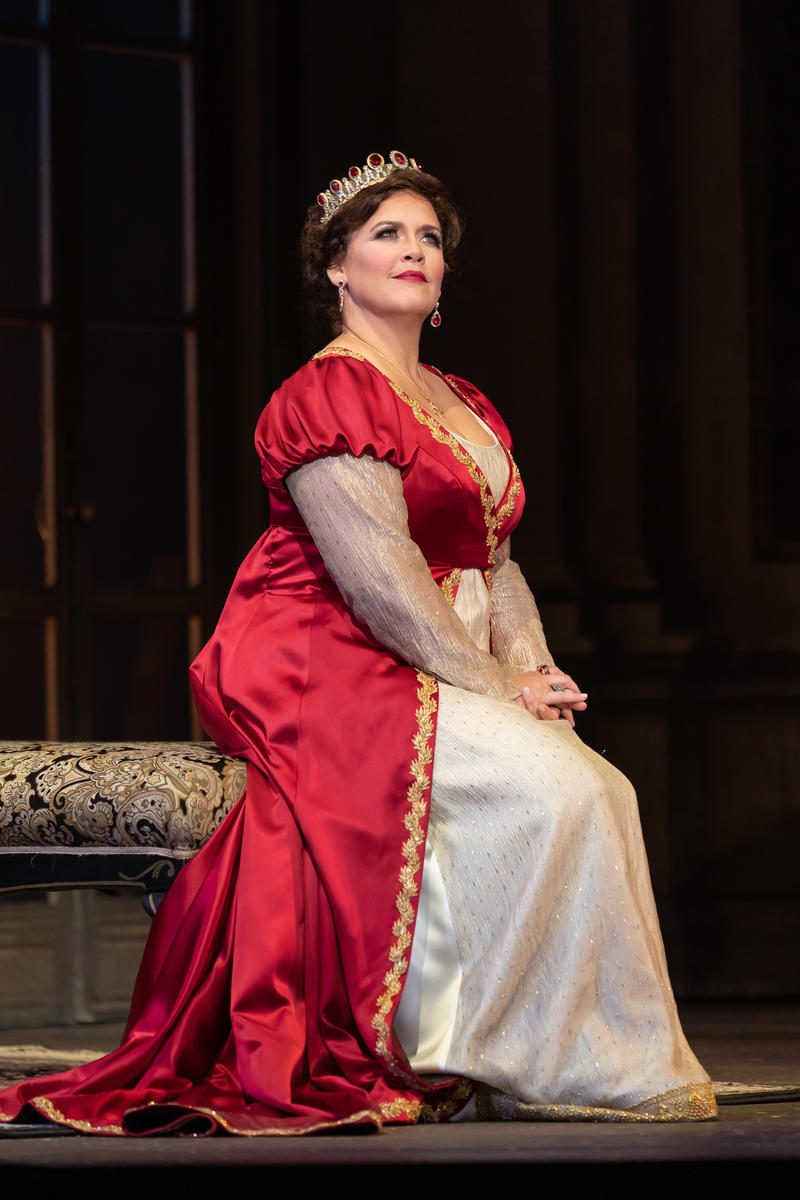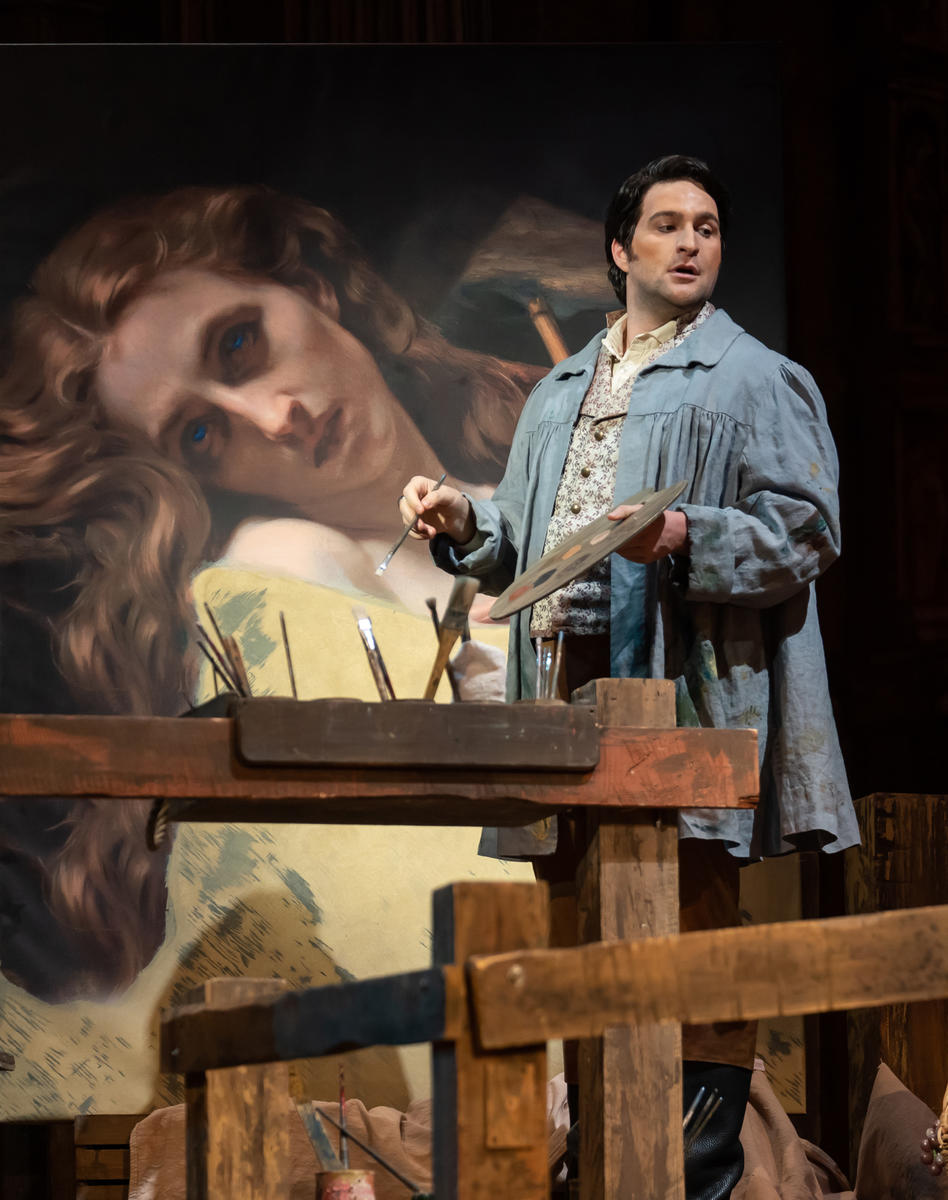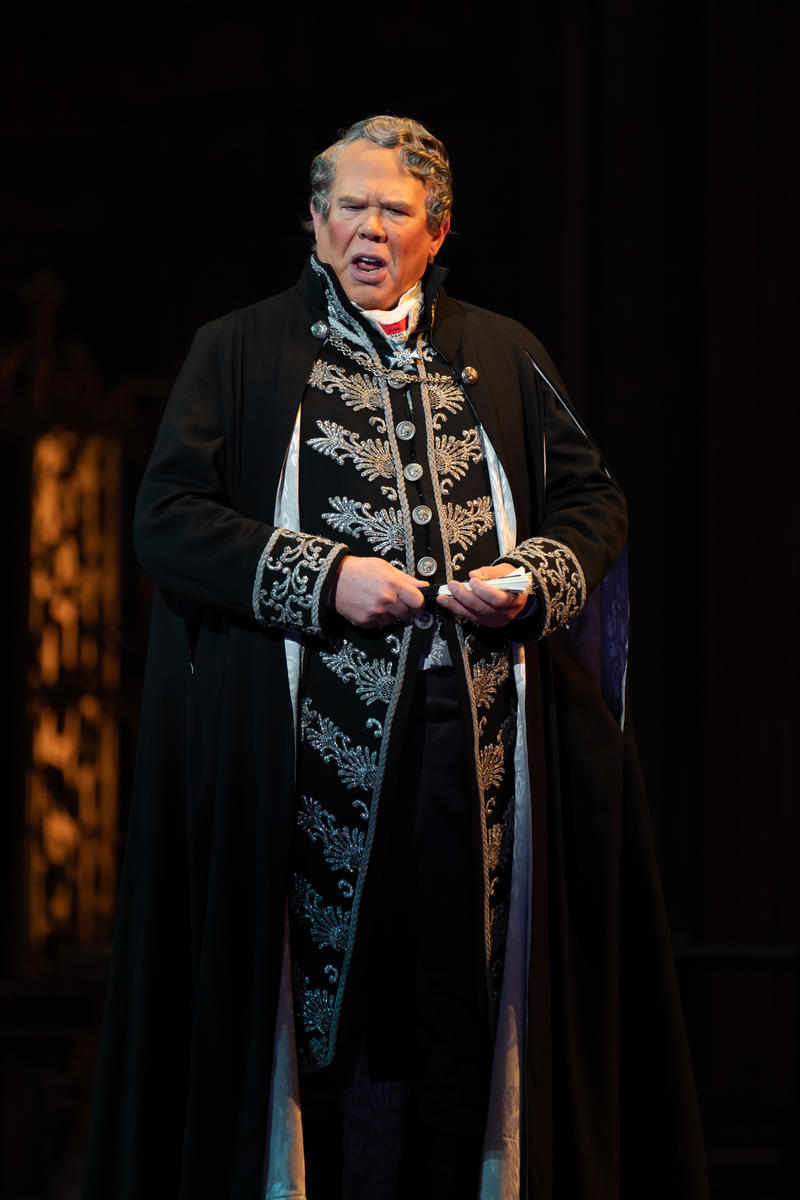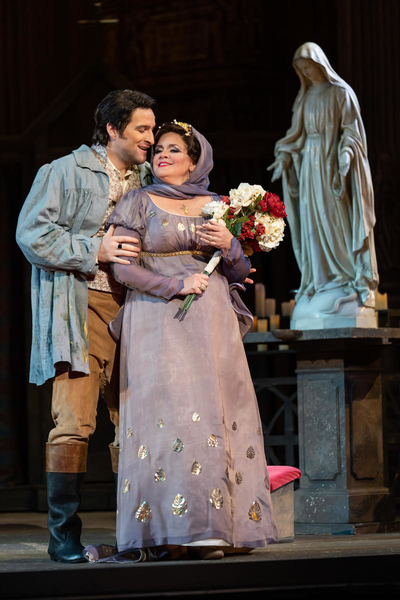If Tosca is playing and you are an opera fan, you go. It’s like your mother wants you to come for Sunday dinner. You feel guilty if you don’t go; you would be letting the family down. You may be tired of Sundays with fried chicken and mashed potatoes and gravy (I grew up in the South), but you go, and in the end, you enjoy the damn fried chicken and mashed potatoes and gravy, and you are glad you did what you had to do. At least with Tosca, it will likely be a different set of relatives each time. Now if you are a new invitee to mom’s Sunday dinner, you will love it and wonder why anyone would want to skip it, even occasionally.
left to right: Keri Alkema as Tosca; Riccardo Massi as Cavaradossi; and Alan Held as Scarpia. Photos by Scott Suchman; courtesy of Washington National Opera.
Tosca (1900), with its Hollywood storyline and melodramatic music, is a good opera for new invitees, so I won’t give away the ending or plot twists. Let’s just say that Tosca, a singer, and her sweetie, the painter Cavaradossi, are in love, but a mean old Roman consul, Scarpia, has his lecherous eye on Tosca and his political eye on her lover. The story takes place in 1800 in Rome, a tumultuous period before Italy was a unified country. Over the course of just two days, there is lots of political intrigue and deception, threats, both sudden and planned violence, and beautiful arias. Tosca is currently number five on the most performed opera list. The composer Giacomo Puccini has two other familiar best sellers to his credit, La Boheme and Madama Butterfly, that also feature Tosca’s librettists Luigi Illica and Giuseppe Giacoasa. The opera is condensed from a play by Victorien Sardou that is a good deal longer, so some significant details may sail past you if are not familiar with the play, especially the historical context. In particular, it is helpful to know that at the time the story takes place, Rome was under despotic Neapolitan rule, managed by a group of powerful consuls. Napoleon had departed Rome as a republic a few years earlier but then the King of Naples added Rome to his holdings. As the events of the opera unfold, Napoleon was fighting for control of Rome again. During the opera, news arrives that he has been defeated, but later we learn that the earlier news was premature, and Napoleon has been victorious, significant because Scarpia is on the side of the monarchy, and Cavaradossi and his friend, the escaped, political prisoner Angelotti, are on the side of the great liberator.
Wei Wu as Sancristan and the Children’s Chorus. Photo by Scott Suchman; courtesy of Washington National Opera.
This Tosca has a fine cast, starting with soprano Keri Alkema who plays Tosca and Riccardo Massi who plays Cavaradossi; both have strong, colorful voices. Ms. Alkema, who returns to the Kennedy Center after having been a member of the original group of Domingo Cafritz Young Artists, sings beautifully and makes a compelling Tosca. One of the treats of attending yet another opera family dinner is getting to see another soprano’s portrayal of the remarkable transformation that Tosca undergoes in Act II, sort of like seeing another soprano’s mad scene in Lucia di Lammermoor. She rendered a compelling “Vissi d’arte”, a truly stunning aria in both melody and lyrics at the end of Act II; she received a well-deserved enthusiastic round of applause. Mr. Massi plays Tosca’s beau with a youthful vigor and Italian charm (he seems to be in the Italian version and everyone else is Anglophile) and delivers the goods with his big, Act III aria, “E lucevan le stelle“; he received a well-deserved enthusiastic round of applause. A couple of times earlier he held his final notes so long he seemed to be saying look at me and what I can do. At first, he reaffirmed my prejudice about tenors (pretty boy show-offs who always get the girl), but then it seemed to come to him so naturally he won me over. The lover’s embraces seemed pro forma, lacking passion, but the banter back and forth to deal with Tosca’s jealousy was amusing and charming.
Michael Hewitt as Angelotti and Riccardo Massi as Cavaradossi. Photo by Scott Suchman; courtesy of Washington National Opera.
Alan Held’s Scarpia was a mix for me. He has the stature to be imposing and threatening, but at other times, as my son commented to me, he appeared more Scrooge-like than monster-like in a one-dimensional role. He has a good voice and sings impressively. I seem to remember liking him better in WNO’s 2011 Tosca than this one (though I loved him as Wotan in the DC Ring). His awaited sacrilegious exclamation about his passion for Tosca and his joining in the Te Deum procession got rained on a bit by the early rise in volume by the orchestra on Saturday night (May 11). Hopefully that will be adjusted in future performances. The staging which was really quite good overall was startling to no good effect in having the back of the church lift away and the processional move towards the audience. On the other hand, the ending we all await was handled very effectively. Kudos to Director Ethan McSweeney. The supporting performers sang well and added credibility to the story, especially baritone Michael Hewitt as Angelotti, bass Wei Wu as Sancristan, and tenor David Cangelosi as Spoletta. The brief appearance of the Children’s Chorus in Act I directed by Steve Gathman was enjoyable.
Alan Held as Scarpia, Samson McCrady as Sciarrone, and David Cangelosi as Spoletta. Photo by Scott Suchman; courtesy of Washington National Opera.
I read that the music in Tosca is through-composed, trying to make the case to musicologists that this opera is more than simply a good melodrama. Operas originally tended to be a series of arias held together by recitatives. OK, whatever; this is great music and there are certainly some show stopping arias along the way. A fun aspect is the use of musical motifs for the characters; most noticeably, you will hear an identifying musical phrase each time Scarpia appears or is mentioned, and his motif actually begins the overture. The orchestra under conductor Speranza Scappucci did a good job of bringing Puccini’s beautiful music to life. I liked their playing better though in Acts II and III. I realized after a while in Act I that I had not noticed the music after the well-done overture, and then later, it seemed to overpower Mr. Held a bit near the end of Act I. As an aside, in WNO’s recent Faust, I noticed the pony tail bobbing up and down at the head of the pit. This time it was a French braid, meaning I feel good seeing evidence that decisions being made as to whom will lead the WNO orchestra are not gender-influenced.
The sets for this production of Tosca, which came from the Seattle Opera production, are beautiful and a perfect backdrop for the opera. The costumes by Lena Rivkina are stunning and add to the romantic atmosphere. The church interior in Act I and the rather large statue of an angel in Act III are uncannily realistic. The sets convey very well the grandeur and beauty of the actual sites in Rome. Very well done and a production highlight.
Riccardo Massi and Keri Alkema as Cavaradossi and Tosca. Let’s remember them as lovers. Photo by Scott Suchman; courtesy of Washington National Opera.
I have no data, but I’d certainly guess that there were a lot of new attendees for this Tosca, judging by the unusually youthful appearance of the audience, and the younger groups seemed to be having a ball. So, go; maybe you will meet somebody nice. Besides, WNO serves up a mighty satisfying plate of Tosca that will be available for another week and a half. Go, support the family. Is that so much to ask?
The Fan Experience: There are six more performances - May 14, 17, 19, 20, 22, 25; note that the performance on May 19 (as did the one on May 12) will feature different singers for Tosca (Latonia Moore) and Cavaradossi (Robert Watson). See the Downey Review of the second cast at this link. Also, heed the warnings about road construction affecting some routes getting to the Kennedy Center and allow plenty of extra time for your commute. In fact, get there early enough to have your supper (I told you I was from the South) at the Kennedy Center; I think the salad bar at the KC Café is a bargain. The pre-opera talk by Robert Ainsley, Director of the Domingo Cafritz Young Artist program, given an hour before the performance, provides insights about the opera that will enhance your enjoyment.







